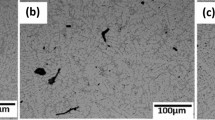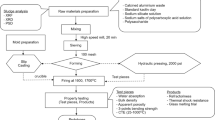Abstract
Recycling activities are encouraged to conserve natural resources and reduce pollution. If waste is pre-treated and appropriately sorted, recycled aluminium can be used for almost all applications. The quality of the secondary material depends on several factors, including the purity of the material, coatings and size. Melting material with larger specific surface causes higher melt losses and greater number of inclusions. The control of impurities is important because they have a major influence on the mechanical properties of recycled alloys. The aim of the study was to determine basic thermal characteristics of the recycled aluminium alloy AA7075 using thermal analysis known as cooling curve analysis and differential scanning calorimetry. It was found that the smallest enthalpy of solidification was measured in sample with greater specific surface, which suggests that high-melting inclusions are present in the sample. Mass losses reached up to 11 mass%. Linear correlation between the specific surface of the input material and the melt losses was confirmed. Metallographic examinations of samples were performed using optical microscopy and scanning electron microscopy. Phases, inclusions and trace elements were determined by energy-dispersive spectroscopy.









Similar content being viewed by others
References
Cui J, Roven HJ. Recycling of automotive aluminum. Trans Nonferrous Met Soc China (Internet). The Nonferrous Metals Society of China. 2010;20:2057–63. https://doi.org/10.1016/S1003-6326(09)60417-9.
Ji S, Gao F, Fan Z. Thermodynamics calculation of extra Mn addition in the recycling of Al–Si–Cu aluminium alloys. Mater Sci Forun. 2017;877:33–8.
Worrell E, Reuter M. Handbook of recycling rombach. In: Friedrich EB, editor. PART II: recycling—application & technology—10: recycling of rare metals. 2010; pp. 1–28.
Gnetnih R, Zlitin A, Kevorkijan V. Challenges and advantages of recycling wrought aluminium alloys from lower grades of metallurgically clean scrap. Mater Technol. 2013;47:13–23.
Schlesinger ME. Aluminum Recycling. Boca Raton: CRC Press; 2014.
Schmitz C. Handbook of aluminium recycling mechanical preparation, metallurgical processing, heat treatment. 2014.
Gronostajski J, Marciniak H, Matuszak A. New methods of aluminium and aluminium-alloy chips recycling. J Mater Process Technol. 2000;106:34–9.
Zhang L, Gao J, Damoah LNW, Robertson DG. Removal of iron from aluminum: a review. Miner Process Extr Metall Rev. 2012;33:99–157.
de Moraes HL, de Oliveira JR, Espinosa DCR, Tenório JAS. Removal of Iron from Molten Recycled Aluminum through Intermediate Phase Filtration. Mater Trans (Internet). 2006;47:1731–6. https://www.jstage.jst.go.jp/article/matertrans/47/7/47_7_1731/_article.
Furu T, Telioui N, Behrens C, Hasenclever J, Schaffer P. Trace Elements In Aluminium Alloys: Their Origin And Impact On Processability And Product Properties. 2010;282–9.
Rakhmonov J, Timelli G, Basso G. Interaction of Ca, P trace elements and Sr modification in AlSi5 Cu1 Mg alloys. J. Therm. Anal. Calorim (Internet). Springer Netherlands; 2018;4. http://link.springer.com/10.1007/s10973-018-7111-4.
Mahathaninwong N, Plookphol T, Wannasin J, Wisutmethangoon S. T6 heat treatment of rheocasting 7075 Al alloy. Mater Sci Eng A (Internet). Elsevier B.V.; 2012;532:91–9. http://dx.doi.org/10.1016/j.msea.2011.10.068.
Malekan M, Shabestari SG. Computer-aided cooling curve thermal analysis used to predict the quality of aluminum alloys. J Therm Anal Calorim. 2011;103:453–8.
Mostafapoor S, Malekan M. Thermal analysis study on the grain refinement of Al–15 Zn–2.5 Mg–2.5 Cu alloy. J Therm Anal Calorim. 2017;127:1941–52.
Cantor B. Impurity effects on heterogeneous nucleation. Mater. Sci. Eng. A [Internet]. 1997;226–228:151–6. http://linkinghub.elsevier.com/retrieve/pii/S0921509396106080.
Qiao N, Liu XK, Jiang XQ, Chen ZQ, Li CM, Che HM. Effect of Cu on the Microstructure of 5052 Aluminum Alloy. Adv Mater Res (Internet). 2014;1081:200–4. http://www.scientific.net/AMR.1081.200.
Mackenzie DS. Handbook of aluminum (Internet). 2003. http://www.crcnetbase.com/doi/book/10.1201/9780203912607.
Kumar PV, Reddy GM, Rao KS. Microstructure, mechanical and corrosion behavior of high strength AA7075 aluminium alloy friction stir welds—Effect of post weld heat treatment. Def Technol (Internet) Elsevier Ltd; 2015;11:362–9. http://dx.doi.org/10.1016/j.dt.2015.04.003.
Mahfoud M, Rao AKP, Emadi D. The role of thermal analysis in detecting impurity levels during aluminum recycling. J Therm Anal Calorim. 2010;100:847–51.
Acknowledgements
This work was supported by the Republic of Slovenia, Ministry of Education, Science and Sport and by the European Commission, European Regional Development. This work was made in a frame of the program Materials and Technologies for New Applications (MARTINA, Grant Number: C3330-16-529008).
Author information
Authors and Affiliations
Corresponding author
Rights and permissions
About this article
Cite this article
Jerina, L., Medved, J., Godec, M. et al. Influence of the specific surface area of secondary material on the solidification process and microstructure of aluminium alloy AA7075. J Therm Anal Calorim 134, 455–462 (2018). https://doi.org/10.1007/s10973-018-7425-2
Received:
Accepted:
Published:
Issue Date:
DOI: https://doi.org/10.1007/s10973-018-7425-2




